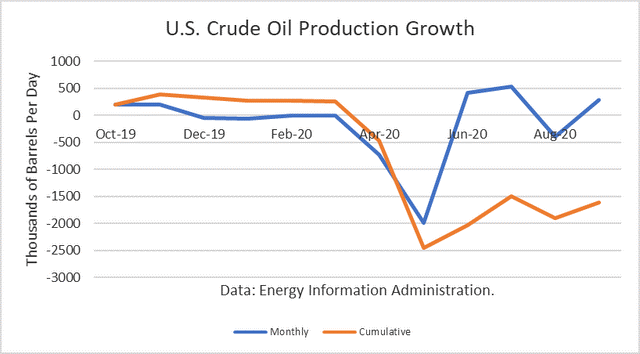The Energy Information Administration reported that September crude oil production rose by 286,000 barrels per day, averaging 10.860 mmbd. This follows a 399,000 b/d drop in August and a 2 million barrel per day collapse in May. The September 914 figure compares to the EIA’s weekly estimates (interpolated) of 10.703 mmbd, a figure that was 157,000 b/d lower.

The primary cause of the rise in production was reversals in the US Gulf Coast from hurricane activity. USG production rose by 315,000 b/d from August, and Texas output fell 60,000 b/d, while Louisiana was unchanged.
Rebounds were largest in North Dakota (61,000 b/d) and New Mexico (19,000). Given the huge reduction in May and this reduction in August, production dropped by 1.609 mmb/d over the past 12 months. This number only includes crude oil. Other supplies (liquids) that are part of the petroleum supply rose by 120,000 b/d from a year ago.


The EIA-914 Petroleum Supply Monthly (PSM) figure was 157,000 barrels per day, higher than the weekly data reported by EIA in the Weekly Petroleum Supply Report (WPSR).

The 914 figure was about 390,000 lower than the 11.25 mmbd estimate for that month in the November Short-Term Outlook. This difference is certain enough to trigger a “rebenchmarking” to EIA’s model in future production levels at this time. Still, since it was due to estimated hurricane impacts, the model may not be rebenchmarked.
The EIA is projecting that 2020 production will exit the year at 11.180 mmbd. And for 2021, it projects an exit at 11.360 mmbd. These rebounds from the August level are in doubt unless oil prices rise through the forecast horizon, but the demand rebound appears to have stalled, and crude stocks are 39 million higher than a year ago.

Conclusions
EIA’s model and real-time estimates for hurricane impacts have poor during this period of massive price changes. Therefore, their forecasts for 2020 and 2021 exit levels are suspect, though the 2020 exit is not much higher than the latest weekly estimate (11.0 mmbd).
A major uncertainty is how producers will behave in 2021, given oil price uncertainties and their diminished cashflow since the pandemic crashed prices. The other major uncertainty is how long demand will suffer from the pandemic and affect oil prices. The latest lockdowns announced for Germany and France are not encouraging.
Check back to see my next post!
Best,
Robert Boslego
INO.com Contributor - Energies
Disclosure: This contributor does not own any stocks mentioned in this article. This article is the opinion of the contributor themselves. The above is a matter of opinion provided for general information purposes only and is not intended as investment advice. This contributor is not receiving compensation (other than from INO.com) for their opinion.
